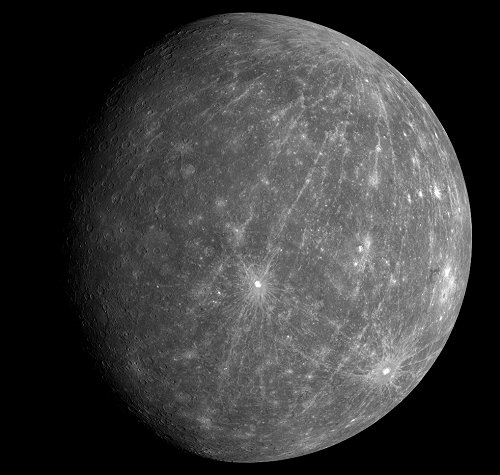|
Table of Contents |
|
Mercury Science |
MESSENGER Reveals Mercury as Never Seen Before
"The MESSENGER team is extremely pleased by the superb performance of the spacecraft and the payload," says MESSENGER Principal Investigator Sean Solomon of the Carnegie Institution of Washington. "We are now on the correct trajectory for eventual insertion into orbit around Mercury, and all of our instruments returned data as planned."
This spectacular image - one of the first to be returned - was snapped by the spacecraft's Wide Angle Camera (WAC) about 90 minutes after MESSENGER's closest approach to Mercury, when the spacecraft was at a distance of about 27,000 kilometers (about 17,000 miles):

|
| This photograph of Mercury's unseen side reveal a dramatic system of globe-straddling rays. [full caption] |
The most striking characteristic of this newly imaged area is the large pattern of rays streaking downward from the planet's northern regions. The ray system appears to emanate from a relatively young crater previously seen in Earth-based radar images but photographed by a spacecraft for the very first time just yesterday. This view of the planet is distinctly unique from what MESSENGER saw during its first flyby in January 2008.
In the mid-1970s when Mariner 10 flew past Mercury three times, the probe imaged less than half the planet. MESSENGER's first flyby in January of this year covered another 20 percent of the planet's surface. Yesterday, Oct. 6th, MESSENGER successfully completed its second flyby of Mercury, unveiling another 30 percent of Mercury's surface that had never before been seen by spacecraft.
"When these data have been digested and compared, we will have a global perspective of Mercury for the first time," notes Solomon.
The MESSENGER team set a new record in accuracy for a planetary flyby. By using solar sailing - rotating the spacecraft and tilting its solar panels to use the very small pressure from sunlight to alter the spacecraft's trajectory - MESSENGER navigators achieved the smallest distance missed between the intended and actual closest approach distance during a flyby of a planet other than Earth.
The probe flew 199.4 kilometers (123.9 miles) above the surface of the planet. "Our goal was to fly 200 kilometers from the planet's surface, and we missed that taget by only 0.6 kilometers," explained MESSENGER Mission Design Lead Jim McAdams, of the Johns Hopkins University Applied Physics Laboratory in Laurel, Md.
That's pretty remarkable targeting, given that MESSENGER has travelled 668 million kilometers since its last deep space maneuver in March, McAdams says. "It's as if we shot an arrow from New York to a target in Los Angeles - nudged it three times mid-stream with a soft breath - and arrived within the width of the arrow's shaft at the target."
Information courtesy of: NASA, NASA@Science, and Johns Hopkins University Applied Physics Laboratory